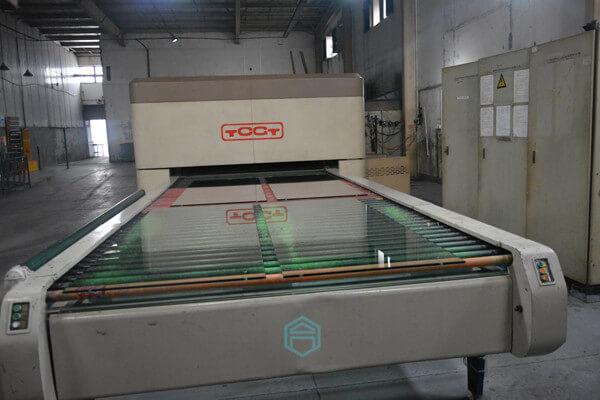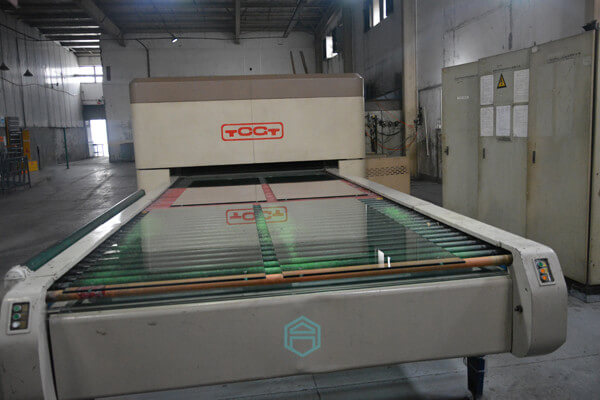
Tempered glass is a type of glass that is manufactured by chemical and thermal processes. Thanks to these processes, an increase in the mechanical resistance and thermal resistance is generated in the glass.
Tempered glass is also called hardened glass, safety glass, fortified glass or reinforced glass. This glass is three to five times stronger than a glass that has not been tempered.
Table of Contents
What is glass tempering?
Glass tempering consists of heating the flat float glass to 650-700 °C, near the softening and stability levels of the glass, and quickly blowing cold air at high pressure on the surface of the glass, so that the temperature difference is generated in the rapid cooling of the glass.
Also, during the manufacturing process, a large number of permanent stresses are produced in the glass. This process is called glass tempering, and this the glass is exposed to compression stresses in its outer layers, while its inner layers are exposed to tensile stresses.
One of the advantages of these permanent stresses on glass is that they generate greater structural impact resistance than untreated glass. Another advantage that we can mention is that in case of breakage, the whole piece breaks into small granular pieces and not into sharp fragments as would happen with an untreated glass.
Let’s now look at some details to know a little more about the differences between the properties of tempered glass and annealed glass.
Properties of tempered glass and annealed glass
| Type of glass | Thermal resistance | Impact test | Surface tension | Cut/ perforate | Self-explosion | Security Performance |
|---|---|---|---|---|---|---|
| Tempered Glass | 250-320°C | 3-5 times | σ<1 Mpa | No | likely to exist | It breaks into small obtuse particles like a honeycomb, it does not hurt people easily. |
| Annealed Glass | 40-50°C | 1 | σ≥69Mpa | Yes | No | After breaking, it features knife-like fragments, and sharp pieces of glass which can hurt people very easily. |
Main standards and certificates of the international market
| International regulations | Certified | Market | Tempering particle count | Surface tension | Impact test |
|---|---|---|---|---|---|
| ANSI Z07.1-2000 | SGCC | USA | 3mm30pcs, 4-12mm40pcs |
α≥69Mpa | |
| AS_NZS_2208_1996 | CSI | Australia,New Zealand | 3-4mm30pcs, 5-12mm40pcs |
α≥69Mpa | 46kgs/mm |
| BS6206-1981 | BS | UK | 3mm30pcs, 4-12mm40pcs |
α≥69Mpa | |
| CAN/CGSB12.1-M90 | Canada | 3mm30pcs, 4-12mm40pcs |
α≥69Mpa | ||
| IN 12150-2: 2004 | CE | EU | 3mm30pcs, 4-12mm40pcs |
α≥69Mpa | |
| GB 15763.2-2005 | CCC | China | 3mm30pcs, 4-12mm40pcs |
α≥90Mpa | 45kgs/1200mm |
What is a good quality tempered glass?
After learning what a tempered glass is, it is important to be able to identify one that is of good quality. We can do this by focusing on certain qualities. Read on to discover the most important qualities.
1. Visible qualities
A visual inspection of the glass should be performed to detect any imperfections or defects. To consider a tempered glass of good quality, it must meet the following qualities:
- There is no pitting on the surface. Pitting is generated to excessive temperature or to the convexity and concavity of the quartz roller during the production of the tempered glass.
- Flatness, especially the absence of hard curves.
- Surface defects, such as the quality of edges and scratches.
- Dimensional tolerance, especially diagonal. For example, the diagonal of the bathroom glass with up to 1mm difference is considered to be of good quality.
2. Invisible qualities
The most important invisible quality is how the glass reacts to being destroyed, the tempered glass can break or explode under normal conditions during use. In the absence of any visible external force, the tempered glass sometimes bursts, which is known as self-explosion, and this can be generated due to very special causes.
These special causes are complex, so keep reading and you will learn what they are:
- The original tablet has stones, sand, nickel sulfide or air bubbles, even if it is invisible to the naked eye. Only select suppliers of high-quality glass, and premium-grade glass.
- Grinding edges, even if there are very small cracks. This can be avoided by using quality glass abrasives and applying excellent quality control.
- Drilling or trimming without slack, or small chips. This can be avoided by using good quality glass drills and applying excellent quality control.
- The safe particle size range is 50~80pcs/5x5cm. If the particle size is too small, greater than 100pcs/5x5cm, the risk of self-explosion of the tempered glass increases considerably.
- Incorrect installation, the glass installation gap is small, and the glass is in direct contact with the metal frame.
The root cause of the automatic explosion of the tempered glass in a state without impact, is determined by its own inherent characteristics. It should be noted that the self-explosion of tempered glass cannot be avoided 100%.
Now, in order to minimize the dangers and losses caused by the self-explosion of tempered glass, we can have two options:
- Tempered glass can be homogenized with high efficiency and low cost.
- A film can also be applied to the tempered glass. Even if it breaks, the glass is still a whole, and the particles will not splash, which ensures that the glass does not harm people. This film offers high efficiency and low cost.
The tempered glass of Apis Glass has a transparent membrane applied on its surface, or a protective film of PET glass. Once the glass breaks, it will not cause harm to our body. Thanks to the fact that the glass is bonded with a safety film that is explosion-proof, the user will not be injured by the splashed glass.
In addition to the above, Apis Glass is an easy-to-clean glass, with a wide variety of designs and colors, and the cost is also much lower than that of laminated glass.
In the following video you can see a demonstration of the operation of this protective film.
Tempered glass applications
Tempered glass is not only applied to meet aesthetic requirements, but is also used for safety and material protection. In the same way it can be integrated architecturally into construction.
Here are the various uses of tempered glass:
- Interior decoration, glass for bathrooms, glass for screens.
- Furniture, coffee tables and table tops, doors and partitions.
- Appliances, TV monitors, ovens, refrigerator shelves, electric heater panels.
- Kitchen dashboards, glass cutting boards, among other applications for the kitchen.
- Doors and windows of buildings, curtain walls, railings.
- Electronic and instrumental industry (mobile phones, MP3, MP4, watches and other digital products).
- Cristal of the side window of the car.
- Photovoltaic solar glass.
Tips for identifying a tempered glass
Every day you live with endless glass products, but in reality, many of those objects that are called glass, are not. Here you can see some examples to identify tempered glass.
- Wear polarized sunglasses to observe the glass by the point of light. To be tempered glass, the surface of the glass must show streaks of color, while ordinary glass does not present them.
- If you look at the glass from the side under the light with the naked eye, there will be blue spots on the tempered glass.
Curiosities of tempered glass
- Ordinary glass can easily break with a sharp metal, such as the tip of a screwdriver. Tempered glass is not easy to break even if a large force or a flat hammer hits the surface.
- Tempered glass cannot be used for the front windshield of the car, because accidental breakage will cause the driver to lose visibility.
- The main component of glass is stone or sand, so it is inorganic, recyclable and environmentally friendly.
- At the time of use/installation, the glass to be placed must be on the floor or on one side temporarily, but cannot be on the floor without protection to prevent damage.
- The design of tempered glass can be done by screen printing.
- Only with ceramic ink, printing before tempering, the ink and glass are integrated when it approaches 700°, and it will never fade.
- Some manufacturers use resin ink that is cooked at about 180º to achieve patterns in the tempered glass. The disadvantage is that it is not sturdy enough and can fall easily, as well as not being environmentally friendly.
Pros and Cons of Laminated glass
In the same way that tempered glass provides safety, there is also another type of safety glass, laminated glass.
Laminated glass has the advantage that it can be easily cut and processed. The disadvantage is that the material of the middle layer of the glass, PVB resin, ages easily. The synthesis temperature is 130-140 °C, and the life span is only 5-7 years, unlike tempered glass which has a life span of more than 15 years.
Final words
As mentioned before, tempered glass is a great ally for a large number of applications, thanks to the advantage it provides by avoiding breaking into sharp fragments reducing the risk of cuts. Another advantage is that tempered glass does not absorb heat and helps keep the temperature more stable.
Similarly, the pressure resistance of a tempered glass is greater than that of a conventional glass. We can say that tempered glass is perfect on many occasions, however, it is necessary to choose the right glass for each of your needs.
If you still have some doubts, at Apis Glass we can provide you with all the necessary information. Contact us and we will be happy to help you.



